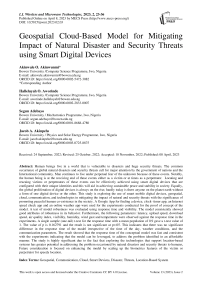Geospatial Cloud-Based Model for Mitigating Impact of Natural Disaster and Security Threats using Smart Digital Devices
Автор: Akinwale O. Akinwunmi, Halleluyah O. Aworinde, Segun Adebayo, Jacob A. Akinpelu
Журнал: International Journal of Wireless and Microwave Technologies @ijwmt
Статья в выпуске: 2 Vol.13, 2023 года.
Бесплатный доступ
Human beings live in a world that is vulnerable to disasters and huge security threats. The common occurrence of global natural disasters and security threats call for major attention by the government of nations and the International community. Man continues to live under perpetual fear of the unknown because of these events. Notably, the human being is at the receiving end of these events either as a victim or at times as a perpetrator. Locating and rescuing victims or perpetrators of these events can be effectively achieved using smart digital devices that are configured with their unique identities and this will aid in achieving sustainable peace and stability in society. Equally, the global proliferation of digital devices is always on the rise; hardly today is there anyone on the planet earth without a form of one digital device or the other. This study is exploring the use of smart mobile digital devices, geospatial, cloud, communication, and technologies in mitigating the impact of natural and security threats with the significance of promoting peaceful human co-existence in the society. A Google App for finding a device, clock- timer app, an Internet speed check app and an online weather app were used for the experiments conducted for the proof of concept of the model. A test of model robustness was evaluated using response time and visibility. The model consistently showed good attributes of robustness in its behavior. Furthermore, the following parameters: latency, upload speed, download speed, air quality index, visibility, humidity, wind gust and temperature were observed against the response time in the experiments. A single sample (one-tail) t-test for the response time with a mean population of 0.9 gave a t-test value of 1. The value of p is 0.162791 and the result is not significant at p<.05. This indicates that there was no significant difference in the response time of the model irrespective of the time of the day, weather conditions, and the communication parameters. The result showed that the response time of the conceptual model was fast and consistent with the experiments indicating that the model can be leveraged, to address the problem identified in an affordable manner. The study is highly significant due to the fact that exploring the technologies that support location-based systems has greater potential in addressing the problem occasioned by natural disasters and security threats to humans. Future consideration is focused on enhancing the model by scaling up the biometrics features of the victim or perpetrator for speedy location.
Geospatial, Communication, Cloud, Smart Devices, Disaster, Threats, Location-Based System
Короткий адрес: https://sciup.org/15019208
IDR: 15019208 | DOI: 10.5815/ijwmt.2023.02.03
Список литературы Geospatial Cloud-Based Model for Mitigating Impact of Natural Disaster and Security Threats using Smart Digital Devices
- A. Moser, J. Bruner, and B. Day, Geospatial Analytics and Data. O’Reilly Media, Inc., 2017. Accessed: Nov. 10, 2022. [Online]. Available: https://www.oreilly.com/library/view/geospatial-data-and/9781491984314/
- “What is geospatial analysis? - Definition from WhatIs.com.” https://www.techtarget.com/whatis/definition/geospatial-analysis (accessed Nov. 10, 2022).
- J. P. Vasseur and A. Dunkels, “Interconnecting Smart Objects with IP: The Next Internet,” Interconnecting Smart Objects with IP: The Next Internet, pp. 1–407, Jun. 2010, doi: 10.1016/C2009-0-20667-2.
- “What is a Mobile Device? - Definition from Techopedia.” https://www.techopedia.com/definition/23586/mobile-device (accessed Nov. 10, 2022).
- “What Is Cloud Computing? A Beginner’s Guide | Microsoft Azure.” https://azure.microsoft.com/en-us/resources/cloud-computing-dictionary/what-is-cloud-computing/ (accessed Nov. 10, 2022).
- “Quantum leap: Global deployment of 5G network for a hyper-connected world - The Economic Times.” https://economictimes.indiatimes.com/tech/internet/quantum-leap-global-deployment-of-5g-network-for-a-hyper-connected-world/articleshow/73010847.cms?utm_source=contentofinterest&utm_medium=text&utm_campaign=cppst (accessed Nov. 10, 2022).
- “What is a Cellular network or Mobile network? | Samsung India.” https://www.samsung.com/in/support/mobile-devices/what-is-a-cellular-network-or-mobile-network/ (accessed Nov. 10, 2022).
- “Find My Device.” https://www.google.com/android/find?u=0 (accessed Nov. 10, 2022).
- “Iwo, Osun, Nigeria Today, Tonight & Tomorrow’s Weather Forecast | AccuWeather.” https://www.accuweather.com/en/ng/iwo/255022/weather-forecast/255022 (accessed Nov. 10, 2022).
- “Online Timer - Countdown - vClock.” https://vclock.com/timer/#countdown (accessed Nov. 10, 2022).
- “Speed Test by Speedcheck - Test my internet speed.” https://www.speedcheck.org/ (accessed Nov. 10, 2022).
- “How to know when air quality is poor | AccuWeather.” https://www.accuweather.com/en/accuweather-ready/how-to-know-when-air-quality-is-poor/693924 (accessed Nov. 11, 2022).
- H. Huang, G. Gartner, J. M. Krisp, M. Raubal, and N. van de Weghe, “Location based services: ongoing evolution and research agenda,” https://doi.org/10.1080/17489725.2018.1508763, vol. 12, no. 2, pp. 63–93, Apr. 2018, doi: 10.1080/17489725.2018.1508763.
- J. Raper, G. Gartner, H. Karimi, and C. Rizos, “A critical evaluation of location based services and their potential,” Journal of Location Based Services, vol. 1, no. 1, pp. 5–45, Mar. 2007, doi: 10.1080/17489720701584069.
- Allan. Brimicombe and C. Li, “Location-based services and geo-information engineering,” p. 394, Accessed: Nov. 11, 2022. [Online]. Available: https://www.wiley.com/en-us/Location+Based+Services+and+Geo+Information+Engineering-p-9780470857373
- J. Raper, G. Gartner, H. Karimi, and C. Rizos, “Applications of location-based services,” Journal of Location Based Services, vol. 1, no. 2, pp. 89–111, Jun. 2007, doi: 10.1080/17489720701862184.
- K. Velikov, “The City of Tomorrow: Sensors, Networks, Hackers, and the Future of Urban Life,” https://doi.org/10.1080/24751448.2019.1571845, vol. 3, no. 1, pp. 123–124, 2019, doi: 10.1080/24751448.2019.1571845.


